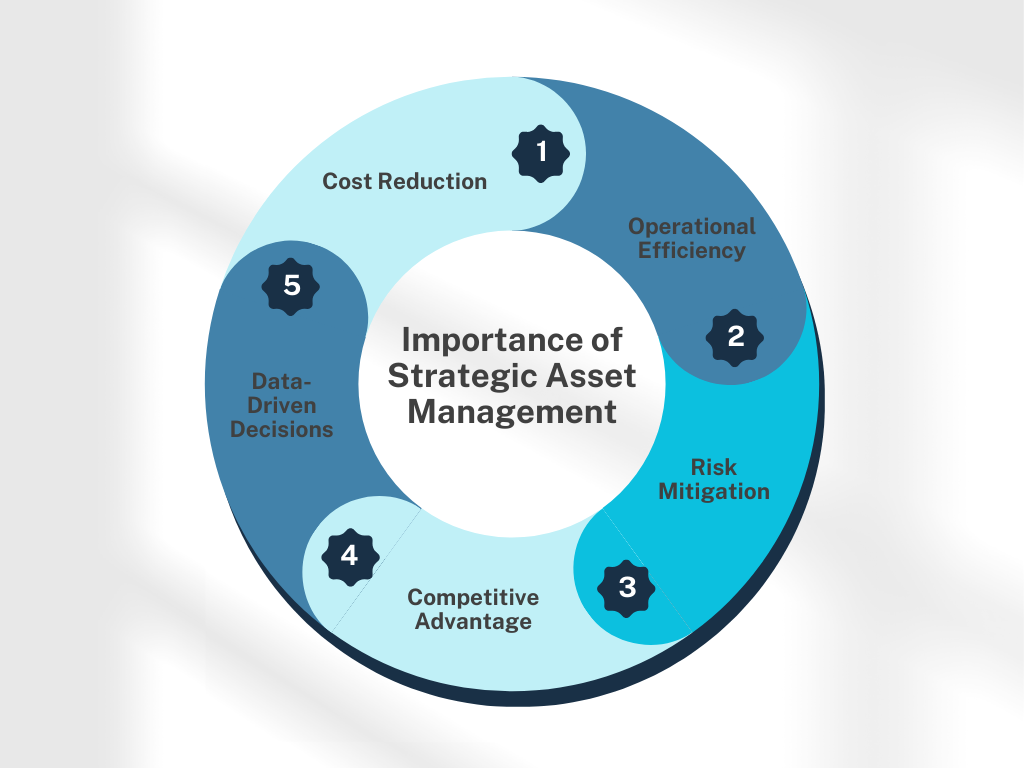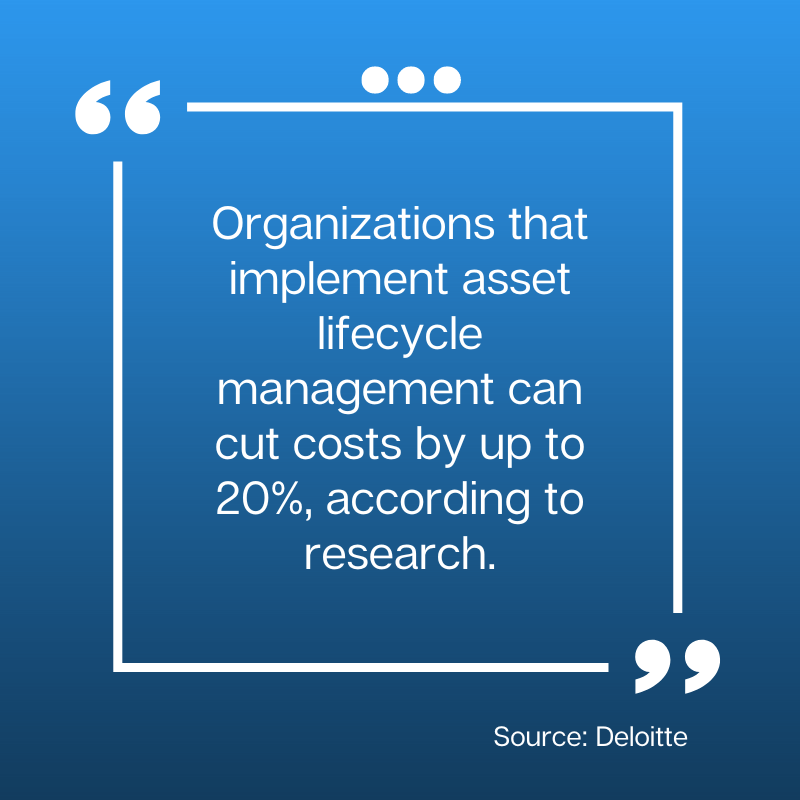Increasing competition and rapidly changing technology make strategic asset management vital to modern businesses. It is a key driver of business success today, yet many organizations struggle to implement an effective asset management strategy.
Research shows that a staggering 80% of employees waste half an hour a day retrieving information critical to their jobs, highlighting the profound impact ineffective asset management practices have on productivity and operational efficiency.
This article discusses what strategic asset management is, its importance, and top asset management strategies to work effectively. let’s start!
What is strategic asset management?
Strategic asset management (SAM) refers to the systematic process of planning, acquiring, operating, maintaining and disposing of an organization’s assets. These assets can include physical infrastructure, equipment, technology, intellectual property, and even human resources. By strategically managing these resources, businesses can increase efficiency, reduce costs, and gain a competitive advantage.
An example asset management strategy might involve conducting regular audits and assessments to identify underutilized or obsolete assets, which can then be retired or repurposed to optimize resource allocation.
The core goal of strategic asset management is to align an organization’s assets with its overall business goals. It goes beyond mere maintenance and extends to proactive decision-making to maximize value and minimize risk.
The importance of strategic asset management to enterprises
The global asset management market is expected to grow at a compound annual growth rate (CAGR) of 34% from 2023 to 2032, making it increasingly important to understand why strategic asset management is so important to businesses.
Organizations should consider strategic asset management for a number of reasons:
1. Reduce costs
Strategic asset management enables organizations to minimize unnecessary expenses associated with asset ownership, maintenance, and replacement. Research shows that with proper asset management, including preventive maintenance, organizations can save up to 12-18% on maintenance costs. By proactively managing assets, businesses can extend their useful life, reduce downtime and avoid costly emergency repairs.
2. Operational efficiency
A Strategic Asset Management Plan (SAMP) can also improve operational efficiency by ensuring assets are utilized to their full potential. By tracking asset performance and utilization, businesses can identify bottlenecks or inefficiencies in their operations and take corrective action. This increases productivity, reduces downtime and increases throughput, all of which contribute to improved profits.
3. Risk Mitigation
Strategic asset management can help businesses reduce risk by ensuring assets are properly maintained and that potential failures are identified and resolved before they cause damage. By implementing proactive maintenance strategies and monitoring asset performance, organizations can reduce the likelihood of unplanned downtime, equipment failure, and other risks that can impact operational and financial performance.
4. Competitive advantage
Businesses that leverage asset management strategies can gain significant advantages by extending asset life, reducing operating costs and achieving optimal performance. With the flexibility to optimize asset utilization, reallocate resources, and adjust asset strategies as needed, businesses can stay ahead of competitors and seize opportunities for growth and expansion.
5. Data-driven decision-making
SAM relies heavily on collecting and analyzing asset data through advanced asset tracking tools. This data provides valuable insights into asset health, performance trends and future maintenance needs. Businesses can use this information to make informed decisions about asset investment, upgrades and disposals.

Top Asset Management Strategies for Enterprises
Strategic Asset Management (SAM) is more than just maintaining equipment; it involves a proactive approach to ensuring assets provide optimal performance throughout their lifecycle.
Here are 10 of the most effective SAM strategies that can dramatically improve your business:
1. Maintain a comprehensive inventory of items
Develop and maintain a detailed inventory of all organizational assets, including their specifications, location, condition and maintenance history.
Such a project repository is the basis for effective asset management and decision-making. It enables organizations to gain clear visibility into their asset portfolio and track assets and inventory to enhance operational workflows.
2. Implement asset life cycle management
Effective asset management involves managing the entire life cycle of an asset from acquisition to disposal. This includes planning for asset replacement, budgeting for maintenance and upgrades, and ensuring assets are retired or replaced when they become obsolete or become too costly to maintain.
According to a Deloitte study, organizations that implement asset lifecycle management can reduce costs by up to 20%. By managing the entire lifecycle of an asset, businesses can optimize investments, reduce maintenance costs and ensure assets are retired at the right time.

3. Leverage technology and automation
Implement asset management software and other automated systems to streamline processes, improve data accuracy, and enable real-time monitoring and analysis of asset performance. Technologies like predictive analytics and integrations like Zendesk and Jira can provide valuable workflows for optimizing asset management.
Leveraging technology and automation can significantly enhance asset management capabilities, allowing organizations to make data-driven decisions, predict maintenance needs and streamline daily activities, thereby increasing efficiency and productivity.
4. Prioritize preventive maintenance
Establish a comprehensive preventive maintenance program to proactively identify and resolve potential issues before they lead to asset failure or costly failure. Regular inspections, condition monitoring and regular maintenance can significantly extend the life of your assets.
Research shows that a properly functioning predictive maintenance program can eliminate 70% – 75% of failures. By prioritizing preventive maintenance, organizations can reduce unplanned downtime, minimize costly repairs, and extend the life of their assets.
5. Optimize asset utilization
Analyze asset usage patterns and implement strategies to maximize asset utilization, such as load balancing, asset sharing, or redeployment. This approach can help organizations get the most value from their investments and reduce the need for unnecessary asset acquisitions.
Optimizing asset utilization ensures assets are used efficiently, minimizing idle time and maximizing productivity. This strategy can result in significant cost savings and improved return on investment.
6. Standardized processes and procedures
Develop and implement standardized processes and procedures for asset management activities, including acquisition, operations, maintenance and disposal. Standardization ensures consistency, increases efficiency, and facilitates knowledge transfer among employees.
By establishing standardized processes and procedures, organizations can streamline asset management operations, reduce errors and ensure best practices are applied consistently across the organization.
7. Provide training to employees
Invest in a comprehensive training program for employees involved in asset management activities. Well-trained personnel can effectively operate, maintain and troubleshoot assets, helping to improve asset performance and longevity.
Providing employees with the necessary knowledge and skills through a training program enhances their ability to make informed decisions, perform maintenance tasks effectively, and contributes to the overall success of the asset management program.
8. Encourage data-driven decisions
Leverage data analytics and reporting tools to gain insights into asset performance, maintenance trends and operational inefficiencies. Use this data to inform decision-making processes and continuously optimize asset management strategies.
According to a report from Aberdeen Group, best-in-class companies are 3-4 times more likely to use asset data to drive decisions. By encouraging data-driven decision-making, organizations can make informed choices based on factual information, identify areas for improvement, and continually refine their asset management practices.
9. Establish performance metrics and reporting
Define and track key performance indicators (KPIs) related to asset management, such as asset utilization, number of checked items, maintenance costs, downtime events and compliance metrics. Regular reporting and performance monitoring enable organizations to identify areas for improvement and adjust strategies accordingly.
By establishing performance metrics and reporting mechanisms, organizations can measure the effectiveness of their asset management strategies, identify areas that require focus, and make data-driven decisions to continuously enhance their practices.
10. Continuous improvement and adaptation
Think of asset management as an ongoing process of continuous improvement. Regularly review and update policies, processes and technology to adapt to changing business needs, technological advancements and industry best practices.
A McKinsey study shows that organizations that continuously improve their asset management practices outperform their peers in revenue growth by 20%. Therefore, organizations must continually enhance their asset management strategies to remain competitive and maximize asset value.
Achieve business goals and reduce costs with structured asset management
Strategic asset management helps organizations optimize investments, reduce costs and gain competitive advantage. By understanding its definition, recognizing its strengths, and implementing the best strategies outlined, businesses can unlock the full potential of their assets. Adopting strategic asset management can facilitate data-driven decision-making, reduce risk, and guide your organization to sustainable success.
Frequently Asked Questions (FAQ)
1. What are the three pillars of asset management?
The three main pillars of asset management include:
- people: Skilled personnel operate, maintain and manage assets efficiently.
- process: Procedures for acquiring, using, maintaining and disposing of assets are defined.
- technology: Tools and systems for tracking, monitoring, and analyzing asset performance and data.
2. What is the main purpose of asset management?
The primary purpose of asset management is to optimize the lifetime value of assets while balancing cost, risk and performance.
3. What are the three categories of assets?
Assets can be broadly divided into three broad categories:
- Tangible assets: Tangible assets that you can touch, such as equipment, buildings, and inventory.
- Intangible assets: Valuable non-physical assets such as intellectual property, brand reputation and patents.
- monetary assets: Investments that hold monetary value, such as stocks, bonds, and cash.
3. What are the three categories of assets?
Assets can be broadly divided into three broad categories:
- Tangible assets: Tangible assets that you can touch, such as equipment, buildings, and inventory.
- Intangible assets: Valuable non-physical assets such as intellectual property, brand reputation and patents.
- financial
Thanks for your feedback!